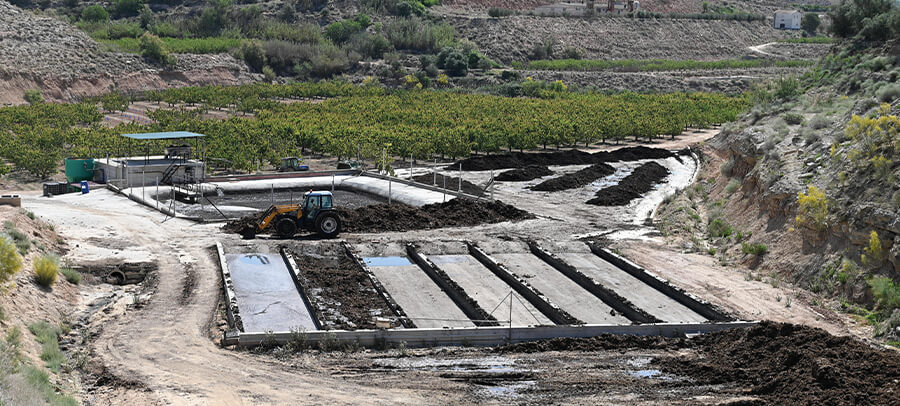Blog
Blog

Biological treatment of pig slurry (I/II)
21st January 2025 - News
Óscar Toledano. Rotecna Sales Manager.
The treatment of slurry is crucial both from an environmental point of view and to maximise the use of the nutrients it contains. On other occasions, we have discussed the physical and chemical treatments we can perform. This article will focus on biological therapies in which microorganisms, mainly bacteria, decompose and transform the slurry components. Below, we will describe several biological methods for treating pig slurry.
Anaerobic digestion of liquid slurry
It is a biological process in which microorganisms decompose organic matter in the absence of oxygen, producing biogas (mainly methane and carbon dioxide) and a digestate that accumulates the nutrients that were initially carried by slurry but more mineralised and stable since volatile organic matter and biological oxygen demand (BOD) is reduced. The biogas produced in the process is a renewable source of energy.
Nitrification
It is a process in which nitrifying bacteria transform the ammonium (NH₄⁺) present in nitrate (NO₃⁻) in the presence of oxygen in two stages: first oxidation of ammonium (NH₄⁺) to nitrite (NO₂⁻), followed by oxidation of nitrite to nitrate (NO₃⁻). This process reduces the ammonium load, decreases the environmental impact, and allows for the safer use of effluents in agriculture.
Denitrification
It is a process that can be carried out after nitrification. In denitrification, denitrifying bacteria convert nitrate (NO₃⁻) into nitrogen gas (N₂) without oxygen. This process occurs in several stages. First, nitrate (NO₃⁻) is reduced to nitrite (NO₂⁻), then nitrite is converted to nitric oxide (NO), then nitrous oxide (N₂O), and finally to gaseous nitrogen (N₂), which is released into the atmosphere. This process removes nitrogen from the effluents, reducing the risk of nitrate contamination of water. The environmental aspects of nitrification-denitrification (NDN) nitrogen removal treatments are noteworthy: large amounts of energy are consumed to remove high-value nutrients that should be used, as the synthetic fertiliser industry again consumes energy to synthesise ammonia from atmospheric nitrogen and transport it over long distances. In extreme cases, where slurry production exceeds the absorption capacity of nearby crops, the alternative of separation, stabilisation, concentration and export has much less environmental impact.
Composting of the solid fraction of slurry
Composting is the aerobic decomposition of solid organic matter separated from the slurry by the action of microorganisms in the presence of oxygen, under controlled conditions of temperature and humidity, through which compost is produced, a fertiliser and structuring agent of the organic soil of high quality. This treatment stabilises the resulting compost's nutrients, significantly reducing its pathogen content and foul odours.
Stabilisation
Through natural biological processes, microorganisms decompose organic matter gradually, generally in sequential stages in large ponds (anaerobic lagoon, aerobic lagoon that can include aeration and maturation). Still, they can also be applied directly in the pits inside the buildings, where aeration systems can be implemented. Through the action of aerobic and anaerobic microorganisms, the organic matter present in the slurry is transformed into more straightforward and less reactive products, which reduces its polluting potential and improves its properties for use as fertiliser since the stabilisation processes convert nutrients and organic matter into more stable and less mobile forms. They reduce the pathogen load and improve the ability of these nutrients to be retained in the soil. Such transformations significantly reduce the risk of leaching of contaminants into aquifers. However, these lagoons require careful design to minimise the emission of ammonia and greenhouse gases, such as methane, and soil or groundwater contamination.
Bamboo or macrophyte plant filters
Aquatic and semi-aquatic plants can treat slurry by absorbing nutrients and degrading organic matter. Plants absorb nutrients and facilitate the degradation of organic pollutants through processes associated with the rhizosphere, the area around the roots where microbial activity occurs.
Biofilters
Porous media, such as compost, peat or coconut shells, are used, where aerobic microorganisms adhere and degrade the pollutants in the slurry that passes through them.
The proper method for the biological treatment of pig slurry will depend on factors such as the amount of slurry to be treated, climatic conditions, available space and economic resources. Combining several methods can often deliver the best results, maximising treatment efficiency and minimising environmental impact. In addition, it is essential to constantly monitor and adjust parameters such as pH, temperature, dissolved oxygen in nitrification, etc., to ensure optimal and sustainable treatment.








